Selling Strategies
There are differing thoughts on the most effective way to maximise your solar and battery system. It comes down to what you want to achieve from your energy management: do you want to sell as much as you can to maximise your profit, even if it means you have to draw from the grid because your battery is empty, or do you want to optimise your energy usage, ensuring that you have enough stored energy to get yourself through the night and maximising your warranty?
Energy Manager can cater for both of these strategies. Below are suggestions on how to achieve both, along with some potential pros and cons of each method. You may feel that somewhere in between is the ideal place for you.
Preamble
Warranty Periods
Definitions of warranty periods may differ between brands, but in general there are two definitions or conditions of a battery warranty period:
1) Length of time, e.g., 10 years
2) Number of charge/discharge cycles, e.g., 4000
The battery state of health (SoH) should stay above a specific value during the warranty period, otherwise it is time to claim on your warranty. Generally, the SoH limit will be either 60 or 70%. This figure will differ between brands, so it's important to look up your own warranty conditions.
The warranty period is usually defined by whichever of the above two conditions comes first—either the time period or the number of charge/discharge cycles. So if you charge and discharge your battery a lot, you may not get to the 10 years before your warranty is no longer valid. Likewise, if you don't use your battery much, you may not cycle it enough to meet the 4,000 (for example) charge/discharge cycles, and your 10 years will come up first.
It is important to understand how your own particular warranty works, because if you are very aggressive with your charging/discharging cycles, you may be severely shortening your warranty period without knowing it. The key metric to watch is your cycles per day. To work this out, the following simplistic formula should be able to give you an indicative figure:
Total amount of battery discharge since purchasing the battery / Battery Capacity / Number of days that you have owned the battery
Total amount of battery discharge: 6,500 kWh
Battery Capacity: 20kWh
Number of days the battery has been owned: 360
Battery cycles = 6,500 / 20 / 360 = 0.9 cycles per day.
How many battery cycles per day could we use to meet 10 years exactly? The answer would be 4,000 / 3,650 (that is, 10 years) = 1.096 per day.
Check your warranty so you understand your conditions. Some brands, for example, Tesla, state that if you use your battery for anything except passive charge/discharge (i.e., you cannot participate in a VPP), your cycles per day is reduced.
Example - Tesla PowerWall 3
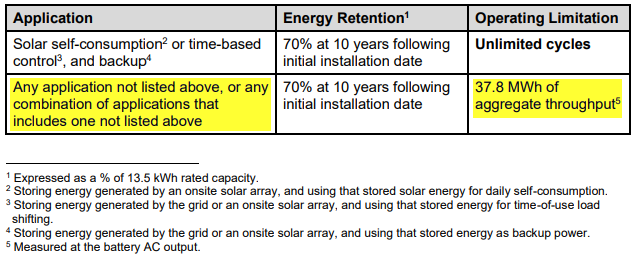
You can see that the Tesla warranty is unlimited cycles over 10 years (which is really good), but if you use it for anything that is outside of passively using it (e.g., a VPP would be excluded), a limit is put on how much aggregate throughput (output) it has produced to stay within the warranty period. At a battery size of 13.5kWh, the daily battery cycle limitation would be 2,800 cycles (37.8MWh = 37,800 kWh, then divide by battery capacity of 13.5 kWh, which gives 2,800 cycles). To obtain a 10-year warranty, you could only have 280 cycles per year, which would be 0.77 cycles per day.
Cost of discharging your battery
It is a fact that over time your battery will deteriorate and will hold less charge. It is estimated that the state of health (SoH) will decrease by between 1-3% per year, so after 10 years, your battery may only hold 70-90% of its original capacity. There is nothing you can do about this; if you use your battery, it will slowly deteriorate.
What this means for energy management is that the more often you cycle your battery, the quicker your battery health will deteriorate. So in reality, there is a cost to discharging your battery.
Let's do some quick hypothetical napkin maths (add in your own figures for your situation):
Cost of battery: $10,000
Capacity of battery: 20 kWh
Warranty period of batttery: 10 years (note, we will use this figure, but assume the battery will last a bit longer than the warranty period)
Cycles per day to stay within 10 year warranty period: 1.09
Maths:
- Total discharge over 10 years to stay within warranty: 20 kWh x 1.09 x 3,650 = 79,570 kWh (79.5 MWh)
- Cost per kWh of energy discharged: $10,000 / 79,570 kWh = 12.57 cents per kWh.
Summary: If you are taking into consideration the cost of your battery when discharging, it will actually cost you, in this example, just under $0.13 per kWh to discharge your battery.
Some people take the cost of the battery, in that it has a finite number of charge/discharge cycles, into consideration when deciding on the price to export their energy to the grid. Others don't care. Which category you reside in is up to you.
Maximise your profits no matter what
If you don't care about the cost of discharging, then the "Maximise your profits no matter what" aggressive method may be the choice for you.
With this method, you want to lower your sell prices to something quite low, so that you discharge all your stored energy each night. What figures you want to discharge at will be entirely up to you and your situation—but you will want to consider that if you discharge all your energy at a price that is too low, you will need to buy it back at potentially more expensive prices. Why would you ever want to do that? What you need to do is work out the sell price that discharges your battery completely just at the time that the sun is coming up again so that you don't have to purchase anything. This will be trial and error and will most definitely change between seasons as your power usage changes. Air conditioning and heating for the winter with less solar generation, or air conditioning with no heating and lots of sun in the summer?
Normal Mode
The first option is to use the Normal Mode configuration and drop the sell prices down to what you deem acceptable feed-in prices. This method will still sell at a graduated price, allowing you to limit what you would be willing to sell your stored energy at when the battery empties.
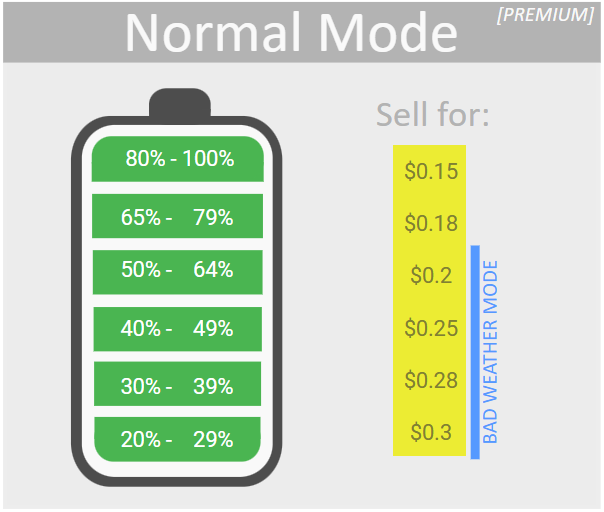
High Sell Mode
The second option is to enable the High Sell Mode and set a single price that you will let your stored energy go for and drop the amount you want to reserve down to something low, like in this example 20%. You could drop it right down to 0% if you really wanted to sell everything you had, though it is not generally good for your battery to constantly be completely emptied. This could wear out your battery much quicker than if you kept a 10-20% reserved SoC.
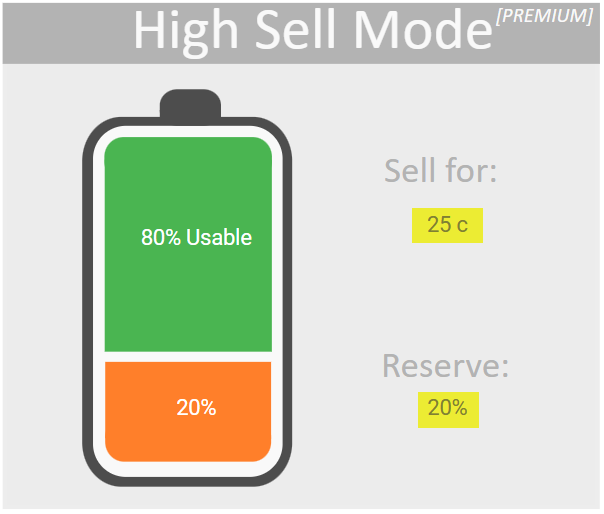
Optimise your energy while making the most of price spikes
Perhaps a safer way is to optimise your battery so that it sells when it is beneficial, but not sell it just for the sake of it. This takes into consideration the wear and tear on your battery hardware and the cost of exporting power in charge/discharge cycles. This is the recommended method for Energy Manager, but it is completely up to you if this is right for you or not.
Normal Mode
What sell price you're going to allow your stored energy to be exported at is completely up to you and it will totally depend on your battery capacity and typical power usage in your house.
Below are suggested levels for a system specced with about 10 kWh of available capacity that can be discharged to the grid without impacting your household use.
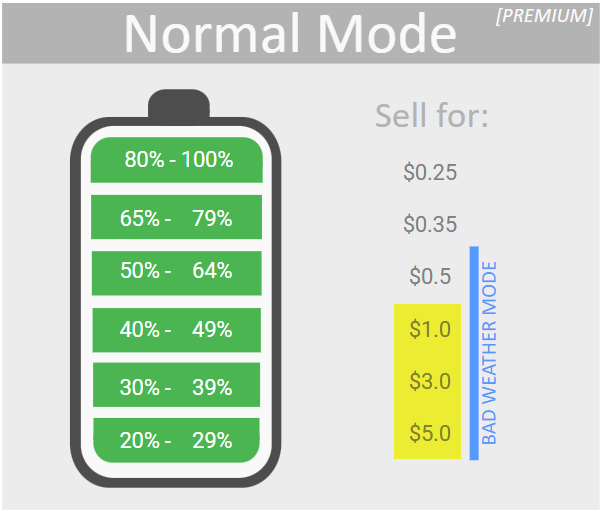
The idea here is that it lets the export of your stored energy quite easily when your battery is full, but as your battery empties, restrictions are placed on what price you'd continue to let the power be sold for. When the battery gets down to about 50%, the sell price would need to be considerably more for it to discharge. However, when the price gets really high, it will allow the energy to be sold as it will probably be cheaper later on to buy from the grid; much less than what you were paid to export it previously.
It is very important to note that if a price spike of a long duration were to occur, you need to ensure that you do not run out of stored energy before the price spike has concluded, or else you will have to purchase the energy back again at potentially extremely high prices.
High Sell Mode
The other option is to simply use the High Sell mode, but ensure that the reserve percentage is enough to keep you self-sufficient until the generation were to occur in the morning.
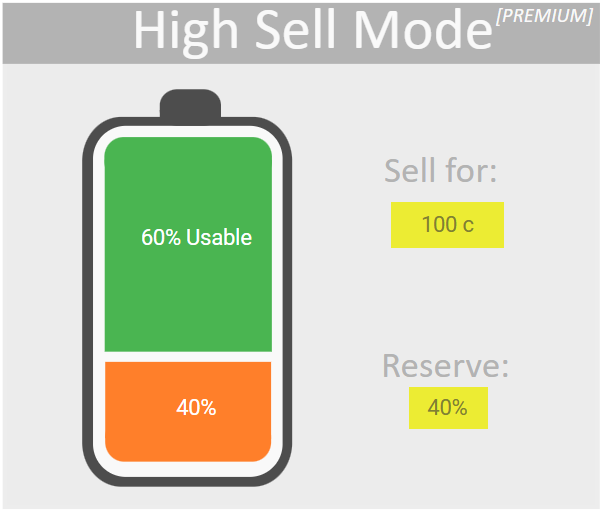
In this example, we will only sell when the price is over $1, but will take the battery right down to 40%. This may be a bit conservative for most, so play around with the sell price to make it work for your battery size and house usage requirements.
Important considerations for Price Spikes
Price spikes arrive at unexpected times—predictions generally occur a good number of hours prior, but most don't eventuate. However, some do—some are quick and sharp price spikes, others are sustained high or extreme prices. It is very important to understand the best strategy to use when each of the different types of price spike occur.
Relatively short price spikes
Below is a graph of a relatively short price spike that occurred in June 2025. The main part of the spike lasted for under 1 hour, but prices were high for roughly 2 hours.
Most battery systems can survive exporting stored energy for the duration of this spike. Some battery systems would still retain enough power to get the house through the night, but others may need to draw from the grid if too much power was exported. Either way, if power had to be drawn from the grid later on, it would have been cheaper than the sell price during the spike, so profit would have been maximised.
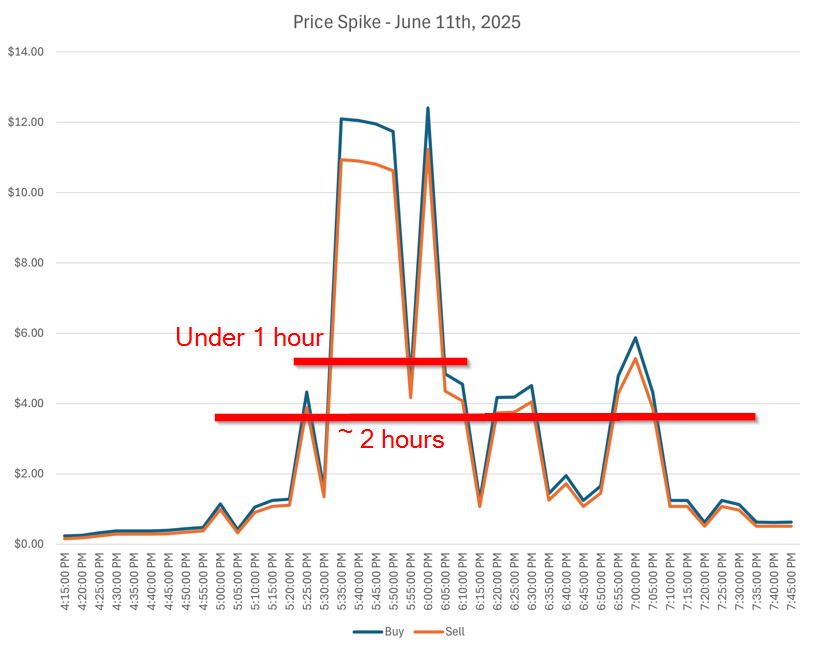
Recommended Strategy for Short Price Spikes
Normal Mode is the recommended mode to use for short price spikes. It allows high selling at any battery level (assuming you haven't set the prices ridiculously high) while retaining stored energy for self-consumption. This, of course, assumes your battery is specced appropriately to allow some discharge and still get you through the night without drawing from the grid. However, it must be said that short price spikes are generally not a concern for any mode due to them coming and going quite quickly. The concern is when the prices are sustained high for many hours (as addressed in the next section).
Sustained price spikes
Below is a graph of a sustained price spike that also occurred in June 2025. It caught a lot of people out because they could not sustain an export of that length of time without having to purchase from the grid at the extreme prices, but they had already exported all their stored energy. They obtained good sell prices for their exports, but then had to purchase it back at an even higher price!
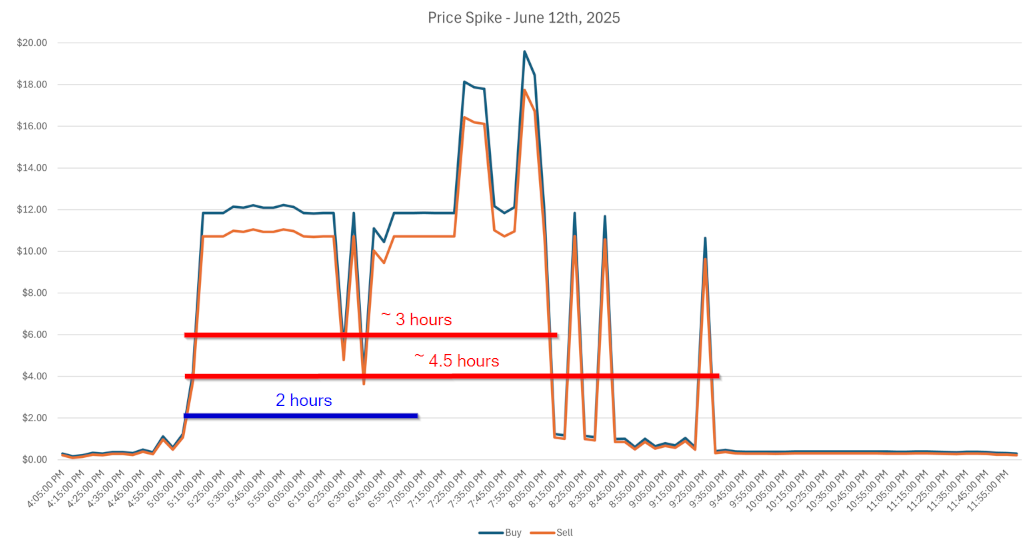
You need to be able to make the most of the high sell prices but limit how much you export so you can make it through the complete price spike period without taking from the grid. By limiting what you export, you can maximise your profits. It may sound counter-intuitive, but you never want to buy from the grid during a spike so it is better use your own stored energy than sell it all.
In the above example, to maximise your profit, you would have had to have been able to sustain battery discharge for 4.5 hours (or at least 3 hours if you're willing to take a couple of spikes on the chin). Of course, you don't know how long you need to last when a prediction is just that, a prediction. However, that being said, you can generally get an idea of how long it is likely to last from experience. If you can see a lengthy spike predicted, it is probably smarter to err on the side of caution and do your calculations on the complete predicted spike period. Of course, you can risk it if you want; that is completely up to your own personal risk appetite.
Recommend Strategy for Sustained Spikes
The High Sell Mode is highly recommended for sustained spike periods. Have your High Sell Mode configured in advance and just enable it for sustained spike periods. This way, you can set the sell price at, for example, $4, and it will only export above this price. Often sustained spikes start relatively low, for example, $1/kWh, and then they go higher about an hour later. If this is the case, and you only had a limited amount of power to sell, you've actually already sold it at $1/kWh when you should not have sold but released it when it increased over $10/kWh. Even then, if you have only two hours of sustained export ability, you need to time it in for the peak predicted times. Be careful, though, if the spike doesn't eventuate, you will have lost your opportunity to sell—so it's a balancing act and does need planning.
The diagram above marks 2 hours in blue. This is generally the length of time most people can issue a sustained export for. If you run out of stored energy at this mark or before, then you somehow have to make your way through the remaining spike period without drawing from the grid—so consider your reserve setting very carefully.